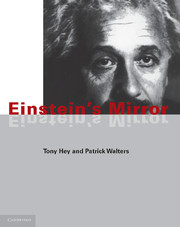Book contents
- Frontmatter
- Contents
- Preface
- 1 A revolution in time
- 2 The nature of light
- 3 Light and time
- 4 The ultimate speed
- 5 E = mc2
- 6 Matter and anti-matter
- 7 Little Boy and Fat Man: relativity in action
- 8 Down to earth
- 9 Warped space
- 10 The Big Bang, black holes unified fields
- 11 Afterword: Relativity and science fiction
- Appendix: Some mathematical details and derivations
- Chronology
- Glossay
- Quotations and sources
- Suggestions further reading
- Name index
- Subject index
- Plate section
Appendix: Some mathematical details and derivations
Published online by Cambridge University Press: 05 March 2013
- Frontmatter
- Contents
- Preface
- 1 A revolution in time
- 2 The nature of light
- 3 Light and time
- 4 The ultimate speed
- 5 E = mc2
- 6 Matter and anti-matter
- 7 Little Boy and Fat Man: relativity in action
- 8 Down to earth
- 9 Warped space
- 10 The Big Bang, black holes unified fields
- 11 Afterword: Relativity and science fiction
- Appendix: Some mathematical details and derivations
- Chronology
- Glossay
- Quotations and sources
- Suggestions further reading
- Name index
- Subject index
- Plate section
Summary
Time dilation
In chapter 3, we promised more details on the derivation of relativistic ‘time dilation'. We considered a thought experiment with a simple clock and two 'observers’ – one at rest relative to the clock and one in motion. We shall now see that the stationary observer sees the moving clock running slow.
Our ‘clock’ consists of a box with a mirror at either end. A light pulse bounces back and forth between the two mirrors, and the time taken for one round trip is taken to be one ‘tick’ of the clock. For an observer at rest relative to this clock, all is fine. Consider how things look for an observer moving in a direction at right angles to the length of the clock (Figure AI). She will see the light pulse start out, and she will see the clock with its two mirrors move away from her with a constant speed. According to her, the light must travel further than just twice the distance between the mirrors. The argument is very similar to that used in the Michelson and Morley experiment. If the distance between the mirrors is denoted by L, and the speed at which the clock moves away from our observer is written as v, we can relate the times measured by the two observers: TR for the observer at rest with respect to the mirrors, and TM for the observer in motion.
- Type
- Chapter
- Information
- Einstein's Mirror , pp. 258 - 263Publisher: Cambridge University PressPrint publication year: 1997



